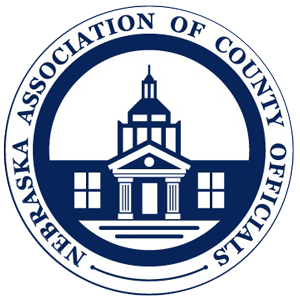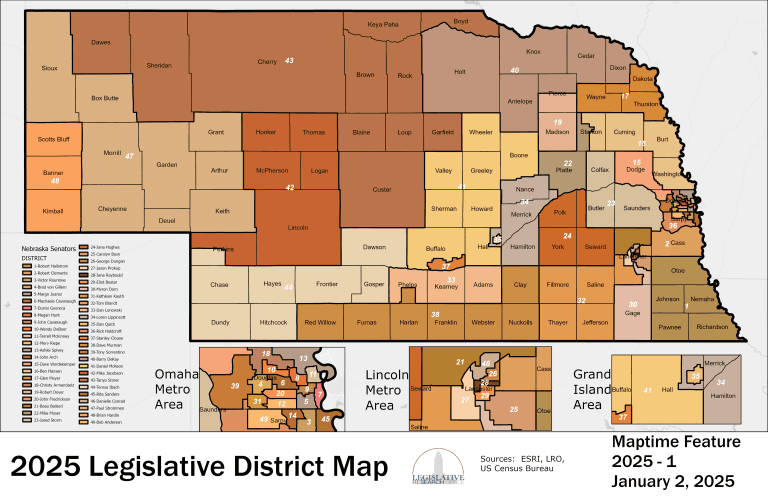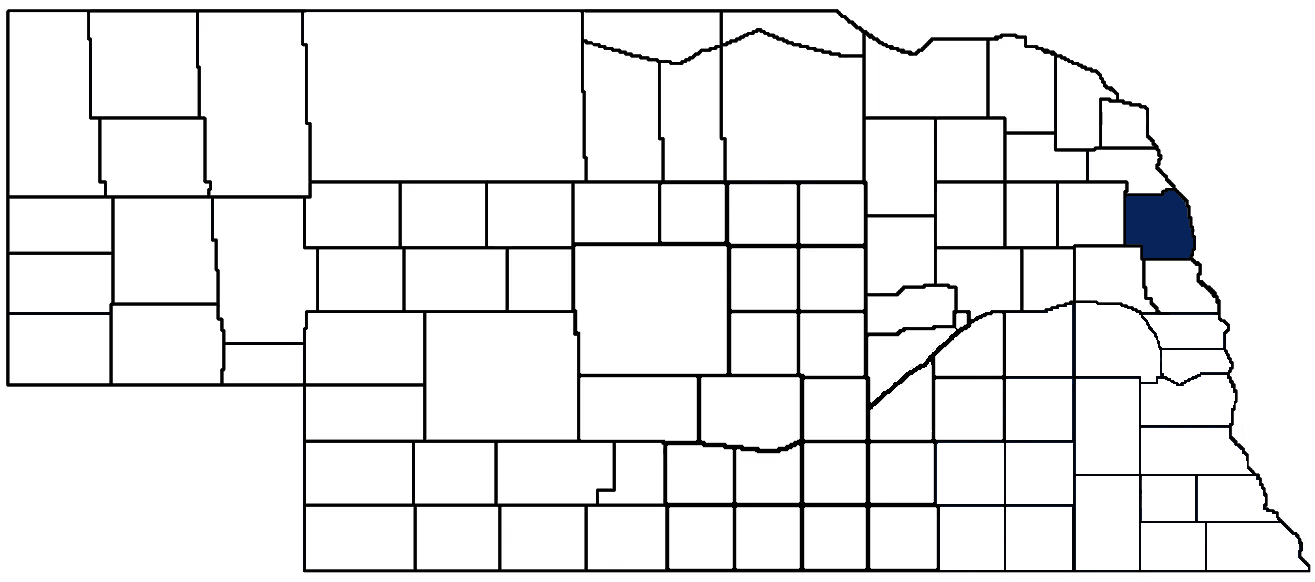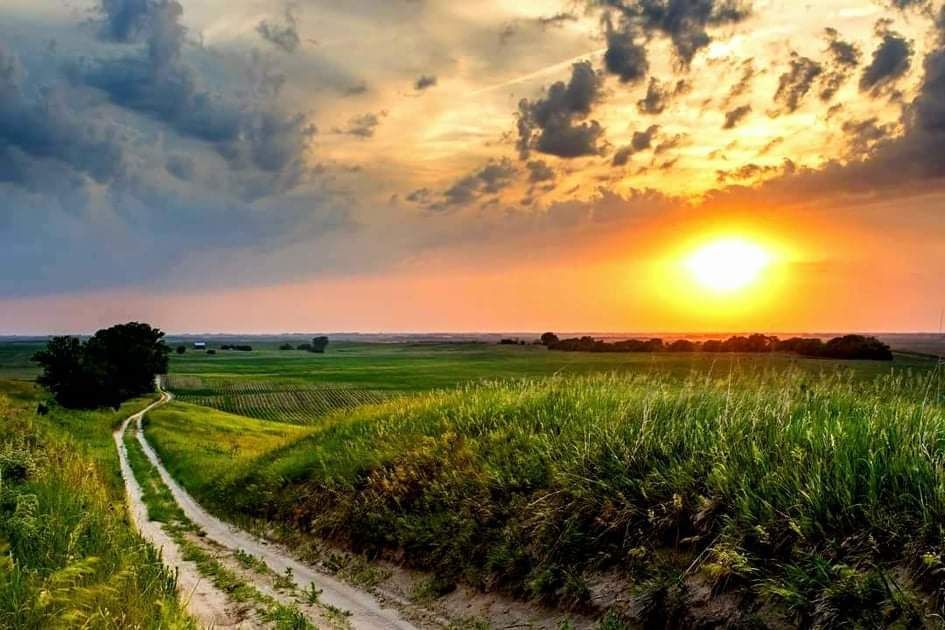- General Info
- Demographics
- Education and Employment
- Valuation and Taxes Levied
- State Senators
- History
- County Programs
- Other Information
Communities and Development
Burt County Seat: Tekamah
Total County Population: 6,722
- Cities (pop. & class): Lyons (824 • 2nd Class), Oakland (1,369 • 2nd Class), Tekamah (1,714 • 2nd Class)
- Villages (pop.): Craig (202), Decatur (410)
- Unincorporated Pop. (% of county pop.): 2,203 (33%) 2020
Land Development (% of total land in county):
- Agriculture: 83%
- By method: Dryland (row crop/grain/forage) (60%); Irrigated (row crop/grain/forage) (18%); Pasture (pure grassland) (6%) • Neb. Dept. of Rev. - total equals agriculture's %
- By commodity: Corn 42%, Soybeans 39%, Livestock (grassland) 7%, Alfalfa 2%, Other Hay 1% • USDA (NLCD) - equals agriculture's % plus some wetlands (2%) and some wooded grazing land (3%) and minus public grassland/wetlands and reserve
- Residential, Commercial, Industrial, Conservation Reserve & Exempt (combined): 17% 2022
County Offices:
Courthouse Address and Hours:
111 North 13th Street
Tekamah, Nebraska 68061
M-F 8:00 am - 4:30 pm
County Board Chairperson: Ted Connealy
Complete list of county board members
County Board Meetings: 2nd Wednesday (except March is 3rd Wed) & 28th of month (or the business day before if falls on weekend)
View the County's Government Maps
NACO District: Northeast
General
Population: 6,722
Land area (sq. mi.): 491.59
Population per square mile: 13.7
Race & Age
Race 2020
White: 92.2%
African American: 0.3%
American Indian: 1.1%
Asian: 0.5%
Hispanic: 2.6%
Native Hawaiian and Pacific Islander: 0.3%
Two or More Races: 3.0%
Age 2020
0-17: 23.3%
18-64: 51.9%
65+: 24.8%
Households
Total households: 2,851 2020
With one child: 270 2022
With 2+ children: 500 2022
With seniors (65+): 870 2022
Socioeconomics
Median household income: $57,303 2023
% of population in poverty: 11.5% 2023
# of housing units: 3,324 2020
Median home price: $135,650 Q4 2024
Owner-occupied rate: 76.7% 2020
2024 building permits for detached single family homes: 15
2024 building permits for non-detached housing units: 0 (townhouse, duplex, or apt. unit)
Technology
Access to broadband (100 Mbps via fiber or cable model): 76.0% 2021
Sources: National Association of Realtors, Nebraska Department of Revenue, Nebraska Legislature, Nebraska Library Commission, U.S. Bureau of Economic Analysis, U.S. Census Bureau (building permits), U.S. Census Bureau (demographics), U.S. Census Bureau (municipalities)
Employment, Schools, and Child Care
Unemployment rate: 3.3% March 2025
County Employment Website: https://nebraskacounties.org/nebraska-counties/county-employment-opportunities.html
High school graduate or higher: 90.9% 2020
School Districts: Bancroft-Rosalie Community Schools, Logan View Public Schools, Lyons-Decatur Northeast Schools, Oakland Craig Public Schools, Tekamah-Herman Community Schools
Bachelor's degree or higher: 22.3% 2020
Community College Service Area: Northeast Community College
Countywide child care capacity: 10 providers; 114 children 2024
Find child care: For a list of child care providers by zip code, visit Nebraska DHHS or the Nebraska Resource and Referral System.
Burt County Economy
Annual Gross Domestic Product (GDP): $439,788,000 2023
Nonfarm Small Business Receipts: $61,589,075 2022
Nonfarm Wage Income: $139,559,000 2022
Farm and Ranch Commodity Sales Receipts: $300,389,000 2022
Farm and Ranch Operations (Non-Sales) Receipts: $10,613,000 2022
- For components of nonfarm small business receipts, nonfarm wage income, and farm & ranch commodity sales and operations receipts, see "Notes" below.
Grain Elevators by Location (bushel capacity):
- Lyons: Lorenson Lumber and Grain (432,940)
- Oakland: CVA (9,503,000)
- Tekamah: Prinz Grain & Feed (607,822)
- (1 bushel = 56 lbs. corn/sorghum, 60 lbs. soybeans/wheat; % max. moisture = 18% beans, 15.5% corn, 14% sorghum/soybeans, 13.5% wheat)
Railroad Miles: 19.38 main, 2.64 side
- Places with Railroad Service: Lyons, Oakland
Local Grain Market: Click for today's grain prices in Burt County
Cattle Producers: 107
- Pastureland Cash Rent (avg.): $72/acre/yr 2024
Crop Producers: 112
- Dryland Cash Rent (avg.): $252/acre/yr 2024
- Irrigated Land Cash Rent (avg.): $294/acre/yr 2024
Farmers Markets:
- Chatter Box Farmers Market in Tekamah (Thursdays 4-7 p.m.)
- Lyons Main Street Farmers Market (June - September, Wednesdays 4 - 7 p.m. and Fridays 9 a.m. - 1 p.m.)
Electricity Providers: Burt County PPD, City of Lyons, Cuming County PPD, Nebraska PPD, Omaha PPD, Village of Decatur
Notes
- Nonfarm small business receipts are reported by partnerships and sole proprietorships. They do not include receipts reported by cooperative associations.
- Nonfarm wage income is reported based upon the wage earner's residential address; therefore, it also includes wages earned by Burt County residents in other counties or states, but it excludes wages earned in Burt County by residents of other counties or states.
- Nonfarm wage income excludes wages earned by anyone claimed as a dependent.
- Farm and ranch commodity sales receipts and operations receipts are reported based upon the farm or ranch owner's principal county of operations; therefore, those figures also include receipts reported by producers operating principally in Burt County for their production in other counties or states, but the figures exclude receipts reported for production in Burt County by producers operating principally in other counties or states.
Irrigation, Drinking Water, and Soils
Rural Irrigation/Livestock Wells: 585 2024
Rural Commercial/Industrial Wells: 7 2024
Rural Drinking Water Wells: 109 2024
Drinking Water Utility Connections: 3,267 Residential; 340 Commercial; 10 Industrial 2024
Irrigation/Livestock Wells per Square Mile: 1.19 2024
Surface Water Diversions (Irrigation): 96 2024
Sources: National Agricultural Statistics Service (USDA), Nebraska Cooperative Council, Nebraska Coordinating Commission for Postsecondary Education, Nebraska Department of Health and Human Services, Nebraska Department of Revenue, Nebraska Department of Transportation, Nebraska Office of the CIO, Nebraska Power Review Board, Nebraska Public Service Commission, U.S. Bureau of Economic Analysis, U.S. Bureau of Labor Statistics, U.S. Census Bureau, U.S. Energy Information Administration, U.S. Department of the Treasury (IRS), Warehouse and Commodity Management Division (USDA)
2024 Levies and Valuations
County levy rate: $0.2471 per $100 of taxable valuation
County property taxes levied: $5,747,737
Total local government property taxes levied: $30,801,365
Total countywide taxable valuation: $2,326,425,808
Federal PILT payment to Burt County (FY2024): $7,014 regarding 2,095 federally-owned acres
Click here for all levy rates in Burt County
County Levy and Taxation Laws
Levy limits
Since 1996, counties and other political subdivisions have been subject to the levy limits listed in Neb. Rev. Stat. § 77-3442 and Neb. Rev. Stat. § 77-3443.
Statutes and regulations
Nebraska Revised Statutes (Chapter 77)
Nebraska Administrative Code (Title 350)
Local tax reductions, exemptions, and credits:
Neb. Rev. Stat. § 76-902(5)(a) (Deed "stamp tax" exemption): "The [stamp tax] shall not apply to: ... (5)(a) Deeds between spouses, between ex-spouses for the purpose of conveying any rights to property acquired or held during the marriage, or between parent and child, without actual consideration therefor."
Neb. Rev. Stat. § 77-201(2) (Valuation of agricultural land and horticultural land): "Agricultural land and horticultural land as defined in section 77-1359 shall constitute a separate and distinct class of property for purposes of property taxation, shall be subject to taxation, unless expressly exempt from taxation, and shall be valued at seventy-five percent of its actual value, except that for school district taxes levied to pay the principal and interest on bonds that are approved by a vote of the people on or after January 1, 2022, such land shall be valued at fifty percent of its actual value."
Neb. Rev. Stat. § 77-6703(1) (Tax credit for school district taxes paid): "(1) For taxable years beginning or deemed to begin on or after January 1, 2020, under the Internal Revenue Code of 1986, as amended, there shall be allowed to each eligible taxpayer a refundable credit against the income tax imposed by the Nebraska Revenue Act of 1967 or against the franchise tax imposed by sections 77-3801 to 77-3807. The credit shall be equal to the credit percentage for the taxable year, as set by the department under subsection (2) of this section, multiplied by the amount of school district taxes paid by the eligible taxpayer during such taxable year."
Sources: Nebraska Department of Revenue
State Senator: Ben Hansen (District 16)
Committees:
- Agriculture
- Business and Labor
- Health and Human Services
- Reference
- Rules
- Executive Board
- Legislative Performance Audit
- Legislature's Planning Committee
- Statewide Tourism And Recreational Water Access and Resource Sustainability (LB406)
Map and statistics for Legislative District 16
Map of all districts in the Nebraska Unicameral Legislature
Burt County History
Number of Registered Historic Places: 14
Year Authorized: 1854
Year Organized: 1854
Etymology: Francis Burt (1st Territorial Governor)
Burt County was originally home to several Native American tribes, including the Pawnee, Omaha, and Winnebago, who lived and hunted in the region for centuries before the arrival of European settlers. The presence of these tribes has had a lasting influence on the county, and their cultural heritage is still evident today in the local museums, historical sites, and Native American ceremonies that take place in the area.
In the early 1800s, European settlers began to arrive in Burt County, drawn by the fertile soil and abundant wildlife. The area was soon transformed by the arrival of the homesteaders, who cleared the land, built homes and farms, and established new communities. Burt County quickly became an important center of agriculture, with crops such as corn, wheat, and soybeans being grown in large quantities. In addition, the county was home to a thriving livestock industry, with cattle, pigs, and sheep being raised on the rolling prairies.
After the Civil War, the county experienced a period of rapid growth and development, as the population increased and new businesses were established. The arrival of the railroad in the 1870s was another important event in the history of Burt County. The railroad completely transformed the county, making it easier for goods and people to be transported, opening up an array of new markets. The railroad also helped to spur the growth of the county's agriculture and livestock industries, as crops and livestock could now be easily transported to previously unreachable markets.
Burt County boasts a wide variety of flora and fauna, including prairie grasses, wildflowers, and deciduous trees. The county is also home to a large number of wetlands and waterways, which provide habitat for a diverse range of wildlife, including waterfowl, fish, and mammals. Uniquely, a popular hunting and fishing area called Tieville Bend is in a portion of Burt County on the eastern side of the Missouri River.
The county has a rich cultural heritage, with a number of historic sites and landmarks that tell the story of the area's past. One of the most important of these is the Burt County Courthouse, which was built in 1884 and is one of the oldest courthouses in the state of Nebraska. Other important landmarks in the county include the Burt County Historical Society Museum, which contains a large collection of local artifacts and memorabilia, and the former Burt County Jail, which was built in 1873 and is now a museum dedicated to the history of the county.
In recent years, Burt County has continued to evolve and grow, with new industries and businesses being established in the area. Today, the county is a thriving and vibrant community, with a strong economy and a high quality of life. Despite its rapid growth, Burt County has remained true to its roots, and its residents are proud of their rich cultural heritage and the important role that the county has played in the history of the state of Nebraska.
Highlight an important program in your county in this space! Send an email to:
Local Highlights
License Plate Number: 31
Time Zone: Central
Number of Veterans: 477 2024
Zoned County: Yes
Number of County-Owned Bridges: 141
Number of County-Owned Dams: 1
Election Data
General Election Turnout: 77% 2024
Total Registered Voters: 4,885 2024
Number of Precincts: 11 2022
Number of Election Day Polling Places: 5 2022
Land Area per Polling Place (avg.): 98.32 sq. miles
Intergovernmental Data
Emergency Mgt. Planning, Exercise and Training (PET) Region: Northeast
Natural Resource Districts: Lower Elkhorn NRD, Papio-Missouri River NRD
State Lands (acres): Pelican Point SRA (36.41), Summit Lake SRA (535)
Federal Lands (acres): Little Sioux Bend (190), Middle Decatur Bend - north (690), Middle Decatur Bend - south (187), Tieville Bend (1,013)
Sources: Nebraska Department of Transportation, Nebraska Emergency Management Agency, Nebraska Game & Parks Commission, Nebraska Legislature, Nebraska Office of the CIO, Nebraska Secretary of State, U.S. Department of Veterans Affairs, U.S. Election Assistance Commission, U.S. National Archives and Records Administration (eCFR)



